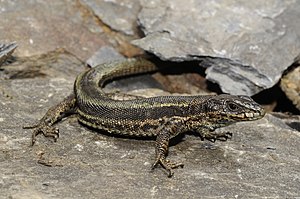Val d'Aràn mountain lizard
| Val d'Aràn mountain lizard | ||||||||||||
|---|---|---|---|---|---|---|---|---|---|---|---|---|

Val d'Aràn mountain lizard ( Iberolacerta aranica ) |
||||||||||||
| Systematics | ||||||||||||
|
||||||||||||
| Scientific name | ||||||||||||
| Iberolacerta aranica | ||||||||||||
| ( Arribas , 1993) |

The Val d'Aràn mountain lizard ( Iberolacerta aranica ) is a species of lizard from the genus Iberolacerta .
features
The Val d'Aràn mountain lizard is a medium-sized lizard. Males reach a head-torso length up to 62 millimeters, females up to 67 millimeters. With its relatively short head, short legs and short tail, it resembles the forest lizard ( Zootoca vivipara ). The back has a grayish base color, which is sometimes brownish or olive tinted. The back of some males is shiny metallic green. There is seldom a fine dark line in the middle of the back. On each side of the back there is usually a series of dark spots that sometimes extend to the tail. In the front half of the body, at the border between the back and the flanks, two irregularly edged, light-colored longitudinal bands have developed. From the area of the temples to the front sides of the tail, a broad, dark brown to black band runs along the flanks. The underside is white, but can have a bluish or greenish shimmer depending on the incidence of light. In the males there are small black spots on the rear ventral shields, in females these are only present in a small part of the animals. There may be a few bruises on the outer ventral shields in a small number of males. The tail of the young is usually as gray as the rest of the body. In a few populations, however, juveniles with blue tails can also be found.
Occurrence
The Aran Rock Lizard is in a small area of the central Pyrenees on the Spanish-French border endemic . It occurs only in the Maubèrme massif , including its foothills between the Val d'Aràn in Spain and the Ariège in France. The entire distribution area is only about 36 km², most of it is in Spain.
Iberolacerta aranica is a specialized high mountain species. It has so far been detected at altitudes of 1900 m (Cabana des Calhaus, Lérida) to 2668 m (near the summit of the Tuc de Maubèrme, Lérida). Their habitat are rubble heaps, scree fields and stony grasslands. The subsoil consists of slate and limestone. At these altitudes, the growing season is only three months long.
Way of life
The annual activity period of the species extends roughly from mid-May to the end of September. Young and adolescent animals can be active until the first half of October. The mating season extends from mid-May to late June. Only one clutch is deposited per year. This usually happens under medium-sized stones from late June to mid-July. A clutch usually consists of 2 to 5 eggs. These are 10 to 15 millimeters long and 7 to 11 millimeters wide. When they lay eggs, they contain fully developed embryos. Young animals were observed from the second half of August. Almost nothing is known about food and predators. The fly species Sarcophaga protuberans attacks part of the clutch with its maggots.
Systematics
The Val d'Aràn mountain lizard was first described by Arribas in 1993. No subspecies are described. Together with Aurelio's mountain lizard ( I. aurelioi ) and the Pyrenees mountain lizard ( I. bonnali ), it is placed in the subgenus Pyrenesaura .
supporting documents
- Dieter Glandt : Pocket dictionary of amphibians and reptiles in Europe. All types from the Canary Islands to the Urals. Quelle & Meyer, Wiebelsheim 2010, ISBN 978-3-494-01470-8 , pp. 381-383.
Web links
- Iberolacerta aranica inthe IUCN Red List of Threatened Species 2013.2. Posted by: Valentin Pérez-Mellado, Marc Cheylan, Patrick Haffner, 2008. Retrieved January 30, 2014.
- Iberolacerta aranica in The Reptile Database